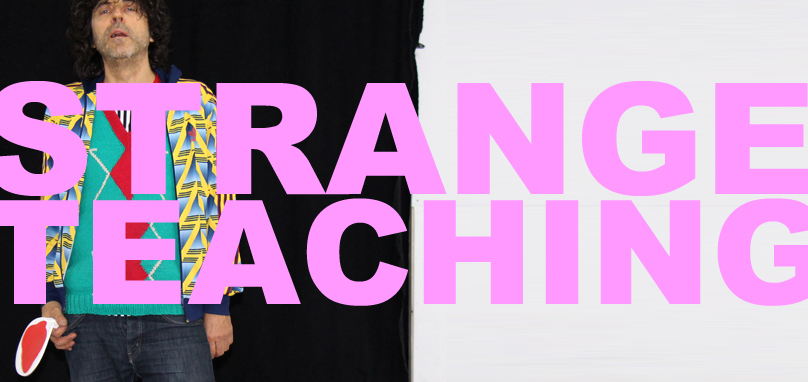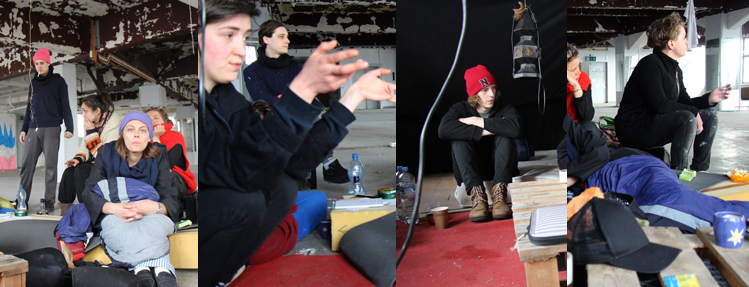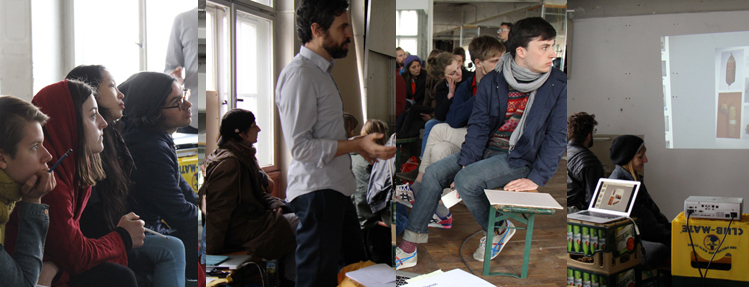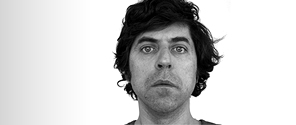
Rainer Ganahl models silicon Ping Pong Racket, by Anna Schwarz at Strange Teaching Fashion Show.
Introduction
When I first came into contact with art schools and their professors and teachers, I quickly realized that they had different effects on different students. My first art professor was Peter Weibel. I had recently graduated with a Master’s degree in philosophy and history from a regular university in Austria, where respect was gained in discussion through contributions based on knowledge and seniority. At my Viennese art school, attitude, social positioning, and quasi-tribal politics ruled; respect was acquired through the proximity to professors and ruling art world VIPs. I couldn’t relate to any of that, nor did I understand their games properly. Being unable to adapt to these new art school hierarchies made me look something of an oddball to my fellow students. I soon got the impression that Weibel, too, perceived me in a non-favorable way. All this eventually became unbearable for me. As a consequence, I showed up only for the few occasions when Weibel gave a talk. But these few presentations by him and the reading of his own texts altered my ideas about art and helped reorient my interests and visual research. Weibel also let me look through Artforum, Flash Art, and other current art ¬journals and documentation which in 1985 were not easily available in Vienna. There was no internet, and libraries did not offer foreign art magazines and articles in a timely fashion. Weibel taught me not only where to find information, but also why some things were important and relevant and why other things were not.
Despite the disharmony between us, Weibel’s influence on my learning and understanding was significant. This stands in contrast to my experience with my next principle art teacher, Nam June Paik at the Academy of Fine Arts in Dusseldorf. Paik was beloved by anyone who encountered him. He was funny, incredibly generous, and helpful, and he liked us all. But I felt that I didn’t really learn more from him in person than what had already been conveyed through his work and in books about him. I liked him and his art a lot, but he didn’t influence my perspective the way Peter Weibel had. Weibel had been very straightforward and people feared his opinions and judgment, something I needed at the time.

Florian Reither addressing the participants at Strange Teaching – Monads with Windows, May 5 – 18, 2014
My next educational stop was the Whitney Independent Study Program (ISP). Coming from Europe in 1990, I entered its intellectual climate at the height of a paradigm shift characterized by postcolonial studies and an orientation towards popular culture. The ISP repositioned my previous knowledge with respect to these new prerogatives and perspectives in a way that continues to mark my practice to this day. Investigating Euro-centrism and cultural arrogance, I could use myself as a good and readily available exemplar. I came to better understand myself and my biased cultural background, a process that is still ongoing; hence, I’m still unlearning. I am still fundamentally marked by these educational experiences and I see or read nearly everything through questions regarding representation and the dynamics of power. But, again, it seemed that the more I learned from my teachers the less well I got along with them. There, I had the honor to study with Hal Foster, Benjamin Buchloh, Mary Kelly, and Yvonne Rainer, among others.
I mention these wonderfully fortunate (though not always well-ending) encounters in order to show that one doesn’t need to get along with a teacher in order to learn something. Not caring about teachers is also consistent with my preferred autodidactic approach to education. This all should offer an explanation to and an apology for why I tell students what I tell them, and why I am not so concerned whether they like me or not. I have had students quit because of my criticism or my disinterest. I do not think that art school ought to be a client-oriented service station, seeking to make students feel good about themselves. The constant flux of networked selfies and Likes can do that job better. I therefore define art education also as a clearing house that points towards the Exit door and hopes to provide immunization for people from this virus. I have seen students’ contaminated to the degree that they ended up perceiving their lives as failures even though they were highly successful in other fields or trades but never could overcome the fact they had not succeeded as artists.
What should art education really be, since it cannot be just reduced to telling people to stop making art?
I find it important to scare people out of the madhouse of false promises and irredeemable expectations. I welcome a negative attitude as part of an important component for any ambitious art education. In fact, I have learned most by people who totally trashed me when I started my way with writing and art-making. Artists and poets live in a world of too much supply and only little if any demand, to put it in economic terms—and we have not yet even begun speaking of money. The chances for anybody in art school to come out and make a living or to succeed critically in the art world is very, very small. Speaking for myself in the role of a teacher, I tell students that they count. I also try to encourage and disrupt; create obstacles and disillusions, confusion and surprises; break early-adapted formulas; facilitate the exit or transfer out of art-making; offer non-sense and an insight into the miserable state of affairs; and, finally, push when they are about to fall.

Reading Leibiniz at Strange Teaching – Monads with Windows, May 5 – 18, 2014
I am perfectly aware that I’m perceived as a good teacher by some and as one who is not worth his salary by others. These two opposite perceptions don’t even have to be seen as contradictory in themselves, as they reflect different degrees of interactions, expectations, and demands. As mentioned earlier, I was learning the most from people I did not get along well, and from those who made my life difficult. But I do consider it important to tell students what I think of their work, even if they end up disliking me and subsequently switch classes or even change schools. I do have some cases in mind who looked for a more nurturing environment and found it elsewhere, though soon after school they ended up as lost and alone with their work as before.
Ad hoc manifesto for art students
ONE
Do what you want to do, no matter what it is. Have fun.
TWO
Whatever you do, it should have something to do with yourself and with your own interests, and not with much else. There is no need to imitate professors, current art trends, or anything chic or trendy.
THREE
Learn only as much as you need to know. Don‘t buy into the idea of learning some or many techniques first and then going on to do your own stuff. When you need to learn something, learn it by doing. If you don’t have anything to say, just don’t bother trying to say it. Be happy if you have to learn in an autodidactic manner. It might be even more promising, if the stuff of your interests is not offered in your art school. Saying this, I do not want to neglect all the great things art students can learn from regular art teachers and their work places.
FOUR
The social environment one encounters on a campus—including their faculty and visiting artists—is the most important thing an art school offers. Embrace it fully, but there is no need run after people ahead of you. Instead, work with the people who want to work with you and create relationships with whoever you can, independent of their standing in the hierarchic pecking order of the given context. All good things derive from you and from the students around you, but don’t expect much else. Organize yourself socially.
FIVE
Redefine success. Every work, every career looks different if it’s really worth the adventure. You have to define for yourself what you want, what you can handle, and what you really need. You have to decide for yourself what constitutes success for you. Be aware of the difference between how you feel and see yourself and how you are perceived by others. Often, artists tend to easily fluctuate between exuberance, arrogance, and depression.
SIX
Accept anti-illusionary education. Embrace a no-future situation. As a second-hand Lacanian might formulate it, love your wounds and keep offering what you can’t deliver. Education is love, love is education. Loosen up. Accept being a loser. Enjoy all the bliss.
SEVEN – Economics
Don’t depend on sales. Try to fix your economic basis otherwise. With few exceptions, artists who want to succeed always find a way to get by somehow. If not, memorize Franz Kafka’s Hunger Artist and recite it for money, or move to Leipzig for as long as it remains dirt cheap. There is always a Brooklyn of the early 1990s, a Berlin of the last fifty years, and a Leipzig of the current moment. Let’s all meet in Odessa soon.
EIGHT
Art and the reception of art is a question of time. There are very few young artists who can cut it all short and hit some kind of jackpot at a very young age, though they may pay a price for it when prices are not sustainable and the downfall becomes graphic. The great curators, collectors, museum directors, and art dealers of the future are most likely studying next to you and all look alike. It is normal to always feel voiceless, powerless, and in need of those who look like they have it all. But ignore all this nonsense.
FINAL MUSIC: YOU GOT THE POWER …
Power is nonsense in the sense that it doesn’t exist by itself. It results from all participants in a given game, a given context. Power always shifts, travels, transforms itself and visit anybody who doesn’t give up ahead of time and capitulate. Today’s Macher, today’s makers and shakers and great artists were yesterday’s students and most likely felt as irrelevant as art students usually feel when it comes to questions of success and power. There is no need to suck up to those ahead and disregard colleagues and peers who enter the circuit later. This self-defeating and unpleasant behavior is unfortunately the predominant style in the art world detectable already in art schools.
The best way to escape this trap is to organize things oneself and to do it with one’s peers and friends. Students really shouldn’t be bothered with much else but their own practices and activities, because only if they manage to connect with themselves and their own generation will they be able to take over from those ahead of them. Every generation will create their own stars and find somebody to fill the role of the curator, collector, art dealer. Anybody might play a role in this vast network of whispers, opinions, and up-and-down mouthing that so greatly influences the various decision-making processes that we feel so dependent upon. The wheel of generational succession will never stop turning.
HAPPY END
The bigger the frustrations and the boredom and ignorance of what people define as successful art, the better and easier it is to break in with better, different, and more exciting art. Hence, we don’t need to complain anymore. Let’s just be really happy and celebrate the fact that there will always be amazing artworks made. Their time will come.
New York / Leipzig / New York 2014
www.strangeteaching.info.

Benjamin Meyer-Krahmer Lecture at Strange Teaching – Monads with Windows , May 5 – 18, 2014
